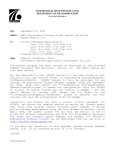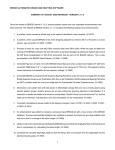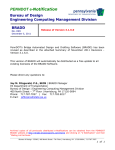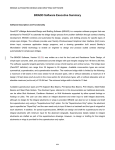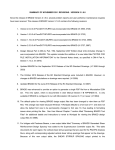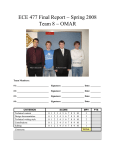Download 011 - PENNDOT LRFD and Engineering Programs
Transcript
PENNDOT e-Notification Bureau of Information Systems Application Development Division PAPier No. 011 Release of Version 1.2 April 19, 2004 The Department’s Pennsylvania Pier Analysis Program (PAPier) has been revised as described on the attached Summary of April 2004 Revisions – Version 1.2. Consultants and others, who have a current license agreement for PAPier Version 1.1 or Version 1.0, can obtain the updated version for a license update fee of $500 for private organizations and $50 for governmental agencies. The forms for Software Update Request and Request for PennDOT’s Engineering Software License can be downloaded from the web site at http://penndot.engrprograms.com. Direct any questions concerning the above to: Hasmukh M. Lathia, P.E. PENNDOT Bureau of Information Systems Application Development Division Phone: (717)783-8822 | Fax: (717)783-8816 e-mail: [email protected] Archived copies of all previously distributed e-Notifications can be obtained from the PENNDOT LRFD and Engineering Programs website at http://penndot.engrprograms.com/home and clicking on "e-Notification" and then "Mailing List Archives." SUMMARY OF APRIL 2004 REVISIONS — VERSION 1.2 Below is the list of corrections made to the PAPIER computer program and incorporated into Version 1.2. 1. An axial force adjustment factor has been added via a new command (the CLC command) to more accurately predict moment magnification induced in columns using the AASHTO single-step method. 2. The correct shaft location is now reported in the input summary table for a 'H1' type pier. [IR #190] 3. A problem with the program aborting when attempting to plot graphics of a rectangular column cross-section with semi-circular ends has been corrected. [IR #189] 4. An error has been corrected in which, under certain circumstances, the program would report an incorrect information code related to the maximum/minimum bar spacing check for the pier cap flexural reinforcement. [IR #187] 5. The required percentage of footing area in compression for spread footings on rock has been corrected from 62.5% to 37.5%. This change affects the footing stability check. [IR #186] 6. Several errors have been corrected when user-specified loads are applied directly to the footing via the UFR command. The forces were being applied about the incorrect axis. Also, the loads were being considered twice if specified in User Load Case #1, but not at all if specified in User Load Case #2. The bottom of column forces were being transformed incorrectly when the footing was rotated relative to the column. [IR #184] 7. The program was reporting buoyancy forces for the footing in the dump file for input files that did not have any water level defined. While the program was not considering these buoyancy forces in the actual footing analysis, the reporting of the force effects caused confusion. [IR #181] 8. The range limits of numerous input parameters have been revised to eliminate warning messages caused primarily by piers taller than 100 ft. and caps and footings longer than 100 ft. [IR #179] 9. A problem with the program aborting when a special live load has been specified in LLC command for piers with 'SS' support condition using LFD specification option has been corrected. [IR #175] 10. The amount of temporary memory allocation was increased to accommodate increased demand caused by multi-column bents on combined footings. [IR #172] 11. The program has been revised such that the area of cap vertical shear reinforcement, after being reduced to account for torsional effects, is never taken to be less than 0.0 in2. In previous versions, the adjusted area of shear reinforcement could become negative resulting in a negative value for Vs. [IR #170] 12. In previous versions, the default values for the parameters of the STP command would be used if the STP command was not specified only if a STS command was included. The program has been revised to always use the default values of the STP command regardless of whether or not a STS command is included. [IR #169] 13. An error has been corrected in the computation of stream flow force results whenever the water level is above the bottom of the cap and when not all three water levels (low, mean and high) are defined. [IR #166] 14. Instead of aborting the run if the final η factor is less than 1.0 or greater than 1.16, a warning message is reported and execution continues with the η factor set to the appropriate limit. [IR #165] 15. Previously, load results from the extreme limit states were excluded from the βD (dead load creep factor) computation for the "strength" condition. The βD factor is a parameter used in the moment magnification equation. The results from the extreme limit states are now included so as to better predict moment magnification effects when the extreme limit state forces dominate the structure response. [IR #164] 16. The default value for cap, column and footing "forces" table has been changed from ‘1’ to '0' in the OUC, OUS and OUF commands, respectively. [IR #162] 17. The program no longer makes the distinction between "soft" rock and "hard" rock for spread footings. Linear pressure distribution and rock stability rules are applied when the bearing stratum is defined using the RCK command, while equivalent uniform pressure distribution and soil stability rules are applied when the bearing stratum is defined using the SOI command. [IR #159] 18. For stream flow skewed to the pier, a change in interpretation of the AASHTO LRFD specifications will result in smaller longitudinal forces on the pier. The documentation in the ‘Method of Solution’ chapter of the user’s manual was correct, but the program was performing the computations differently. Instead of using the projected length of the pier, the program was using the full length of the pier regardless of skew angle. [IR #158] 19. An error with the program aborting with the error message "# of F.E. load cases not in sync - CPRUCLC2" has been corrected. The error occurred when concentrated user loads (specified via the UCL command) were applied near the bottom of a column or solid shaft. [IR #157] 20. An error that resulted in the program aborting whenever user-specified column forces were applied to a solid shaft via the UCL command has been corrected. [IR #156] 21. Various issues related to the handling of pile tension force/capacity for extreme limit states/earthquake load combinations have been clarified and/or corrected. [IR #155] 22. An error was corrected when checking whether or not a pile is located beyond the footing. [IR #154] 23. Narrative was added to the DLB command explaining the difference in Type I & Type II dead load nomenclature used in PAPIER versus STLRFD and PSLRFD. [IR #153] 24. The default concrete cover for walls/shafts/columns was changed from 2" (50 mm) to 3" (75 mm) in the CVR command. [IR #152] 25. DW-type dead loads (Type II dead loads entered via the DLB command) are neglected for column load cases in which the 'Dead Load Factor' is assigned a 'MIN' value (refer to Table 3.6-1 in the user's manual.) This change will negate the need for making two separate runs for modeling the inclusion versus exclusion of DWtype loads (such as future wearing surface or utilities) that might not be present. Also, ‘MIN’ dead load factor is now explicitly assigned to Column Load Cases 9, 14, 19 & 24 for LRFD runs. [IR #148, #43 & #16] 26. The program will terminate execution if the EQL command is used for piers with combined footings. For the combined footing algorithm to work properly, concurrent bottom of column forces must be available and input to the program. Since the SEISAB program does not report concurrent bottom of column forces (only maximum values), an alternate approach to handling earthquake loadings for piers with combined footings is needed. IR #167 was created to address this issue in the future. [IR #147] 27. An error with the program failing to consider water loads ('WA', stream flow and buoyancy) for the Extreme-I and Extreme-II LRFD limit states has been corrected. [IR #146] 28. The program would abort with an error message for a multi-column bent on a solid shaft if the soil thickness on top of the footing exceeded the height of the solid shaft. This error has been corrected. [IR #145] 29. A problem with the program aborting with an error message whenever the left-most column was supported on an individual footing while the other columns of the pier bent were supported on combined footings has been corrected. [IR #144] 30. An additional level of output has been added for the "Reinforcement" parameter of the OUS command in order to reduce the amount of output. An input value of '2' must be specified to obtain the individual bar locations. [IR #140] 31. The weight of the HL design tandem vehicle is now used correctly to compute braking and centrifugal force effects when the HL-93 live load type is designated as 'T1' in the LLR command. Previously, the program was using the weight of the HL design truck. [IR #139] 32. Several errors related to use of the 'stand-alone' footing option (via the FCD and FCF commands) have been corrected. Note that contrary to the Version 1.1 user's manual, combined footings are not permitted for the 'stand-alone' option. [IR #138] 33. In previous versions, the program would abort with the error message "Shear Location Already Found in CPSGSHR" if shear regions were specified to start and end at the exact same location. The program now properly recognizes that this manner of specifying shear regions is valid. [IR #137] 34. User-specified centrifugal and/or braking forces can now be specified via the UBR command in conjunction with user-specified live load reactions specified via the ULL command. However, subvehicle-type matching of forces (e.g., PHL-93 truck versus tandem) is not performed. The largest vertical and lateral loads due to either the truck or the tandem are always used. [IR #136] 35. Transverse and longitudinal offsets specified for footings via the FTG command were being graphed opposite of the correct convention stated in the user's manual. For example, a positive (+) transverse offset value should move the footing to the left of the column centroid. However, when graphic plots were displayed on the screen, the footing was being moved to the right. The error affected the graphic plotting only -- the structural computations were being performed correctly. [IR #135] 36. Mean water level defaulting to the average of high and low water levels is now properly implemented. [IR #134] 37. Changes were made to the routine that interprets the shear stirrup layout entered via the RCV command to resolve a problem with unintended and incorrect stirrup spacings being generated. [IR #133] 38. The program was revised to handle user-defined bearing reactions, entered via the ULL command, for a pier with a combined footing. The previous program logic did not permit this functionality. [IR #132] 39. Program now uses clear spacing instead of center-to-center spacing when evaluating compliance with minimum stirrup spacing criterion. The user is reminded that the minimum spacing criterion is only enforced when the cap depth exceeds 4’-0”. [IR #131] 40. A problem with the program aborting with a 'Bad Column Handle' error when a stand-alone footing file was requested has been corrected. [IR #130] 41. A new input parameter, "Number of Lanes Loaded", has been added to the ULL command. The new parameter had to be inserted into position #3 because of repeatability of the end parameters. Therefore, any existing files that use the ULL command must be modified. This new parameter is used to determine the correct multiple presence factor and to determine the correct number of lanes to include for the purpose of computing centrifugal and longitudinal braking force effects. [IR #129] 42. For a LRFD run only, the program now uses a modified load factor for wind on structure loadings for limit states STR-V and SER-I whenever a design wind velocity other than the 100 mph base wind velocity is specified via Parameter 9 of the WSL command. The intent is to ensure the load factor is always consistent with a 55 mph (90 km/hr) wind velocity. The modified load factor is not used if any of the wind pressure modification factors in the WSL command are entered as other than 1.0. [IR #125] 43. A new table has been added for the reporting of reinforcement layout for columns/shafts. The table is entitled "Flexural Reinforcement Bar Layout" and is intended to be a more user-friendly format for interpreting the program-generated bar locations compared to the "Flexural Reinforcement Bar Locations" table, which gave individual bar locations in X-Y coordinate format. The new table explicitly reports the layout dimensions in the length and width directions, as well as the explicit bar spacings. [IR #121] 44. A separate number of default point-of-interests (POIs) can now be specified for the overhang region and the interior regions of the pier cap for a multi-column bent via Parameter 11 of the CTL command. [IR #117] 45. Column transverse confinement steel reinforcement requirements are fully evaluated for seismic (Zones 2, 3 & 4) and non-seismic (Zone 1) conditions within the plastic hinge zones. [IR #101] 46. User loads are now explicitly checked when determining the applicability of a particular limit state/group load. Previously, if a limit state/group load was not considered applicable (exclusive of the user load), the program would not apply the user load to the user-specified limit state/group load and, if the "Input Summary" parameter of the OUI command was selected, the program would abort with the following error message "INVALID LIMIT/GROUP NUMBER IN LDFGLDAP". [IR #96] 47. The program has been revised to check whether the applied factored shear in a column or shaft is greater than 0.5 φ Vc before reporting an information code indicating that the minimum shear reinforcement requirement was not complied with. [IR #88] 48. Two new input parameters have been added to the CVR command allowing the user to specify that the top and/or bottom flexural reinforcement conforms to the cap surface profile. In previous versions, the user had to specify conformance of the reinforcement to the slope of the cap surface via the RCP command. [IR #84] 49. A new parameter has been added to the LLC command for dynamic load allowance for a permit vehicle. This functionality was added as a result of a new provision added to Article D3.6.2.1 stating that the dynamic load allowance for a permit vehicle need not exceed 20%. This functionality has been made applicable to both LFD and LRFD runs. [IR #78] 50. Cap and column section properties are now reported at all POI locations. In previous versions, section properties were reported only at locations where there was an abrupt change in section dimensions or reinforcement. [IR #76] 51. To be consistent with the SOI command, parameters for the RCK command that are used only for settlement computations are now optional for a LFD run only. If these parameters are not specified, an information code to this effect is reported in the settlement output table. The optional parameters are elastic modulus, Poisson ratio and RQD. The parameters are still required for a LRFD run. [IR #71] 52. A new report table for longitudinal skin reinforcement requirements has been added to the cap flexural analysis report. The intent of this new report is to alert designers for the need to provide supplemental longitudinal reinforcement along the side faces of the pier cap to control web cracking for deep flexural members. Note that the program does not perform an explicit specification check of required versus actual longitudinal skin reinforcement -- it simply reports the required amount. [IR #68] 53. For the computation of stream flow force effects, a triangular pressure distribution (0 pressure at streambed and twice the average pressure at water surface) is now the standard methodology for a LFD run and is optional for a LRFD run. [IR #54] 54. User-defined live load reactions entered via the ULL command were being incorrectly reported in the dump file. The reactions from the last load case were being reported for all load cases. The load computations were unaffected. This error in the outputting of the user-defined live load reactions in the dump file has been corrected. [IR #38] 55. A new parameter has been added to the STS command allowing the user to specify the "mode" of transfer (friction or thermal) of the superstructure temperature and shrinkage force effects to the substructure. This new parameter allows the program to determine the correct load factor to apply. If the mode of transfer is "friction", the AASHTO LRFD specification stipulates the load factor for TU/SH/CR loads is to be '1.0' for the strength limit states instead of '0.5' if the mode of transfer is non-friction (thermal.) [IR #30] 56. Specification checking for lateral forces on foundations has been implemented. For spread footings, this involves a check for sliding. For pile/caisson-supported footings, this check involves comparing actual lateral forces against developed resistances due to battering and/or user-specified 'per pile' resistance. [IR #23] 57. A summary listing of report tables with specification check failures has been added to the formal output and to the screen echo. [IR #5]







